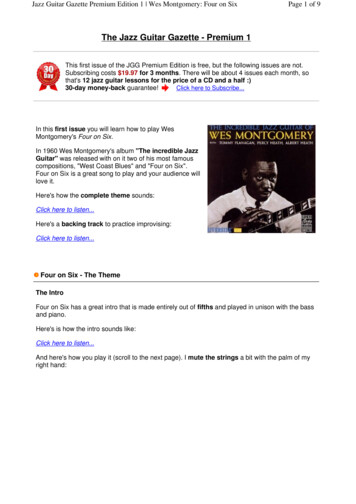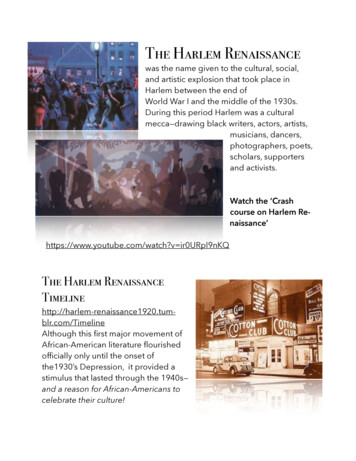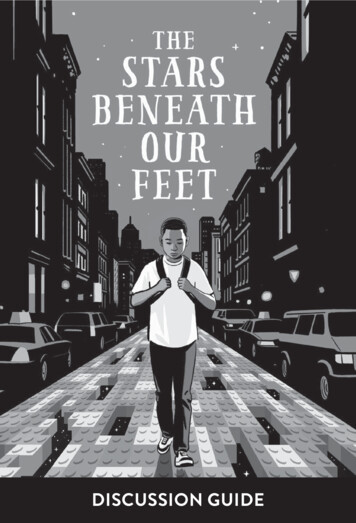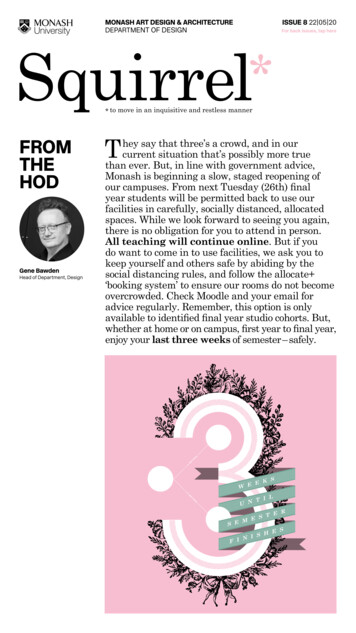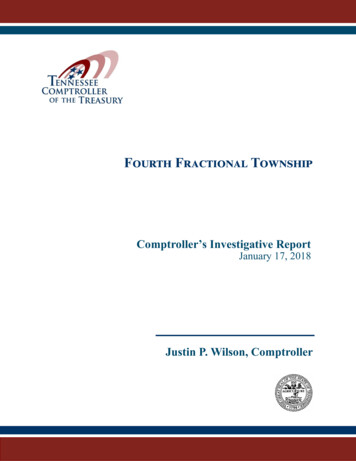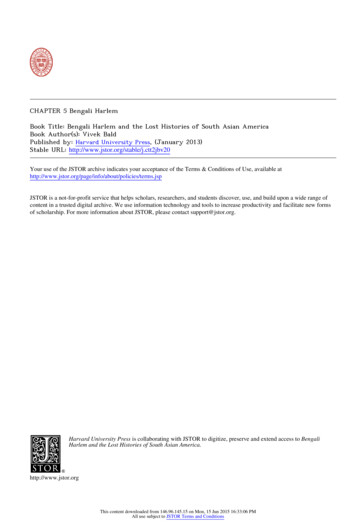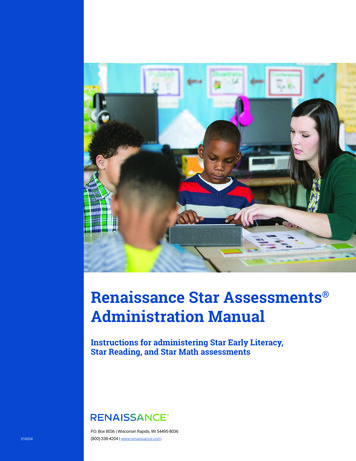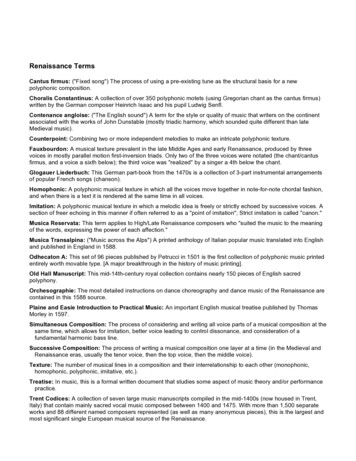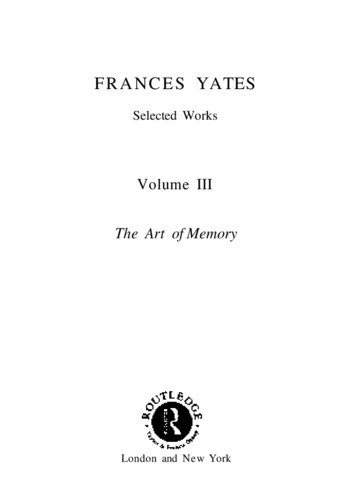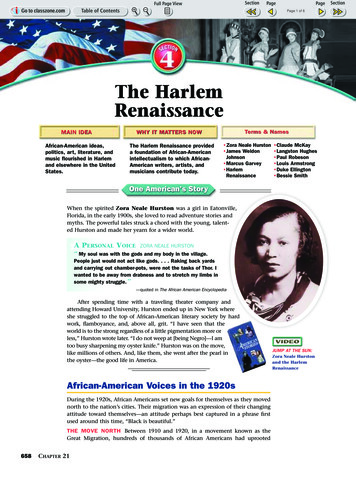
Transcription
p0658-663aspe-0621s410/17/029:03 AMPage 658Page 1 of 6The HarlemRenaissanceMAIN IDEAAfrican-American ideas,politics, art, literature, andmusic flourished in Harlemand elsewhere in the UnitedStates.Terms & NamesWHY IT MATTERS NOWThe Harlem Renaissance provideda foundation of African-Americanintellectualism to which AfricanAmerican writers, artists, andmusicians contribute today. Zora Neale Hurston James WeldonJohnson Marcus Garvey HarlemRenaissance Claude McKay Langston Hughes Paul Robeson Louis Armstrong Duke Ellington Bessie SmithOne American's StoryWhen the spirited Zora Neale Hurston was a girl in Eatonville,Florida, in the early 1900s, she loved to read adventure stories andmyths. The powerful tales struck a chord with the young, talented Hurston and made her yearn for a wider world.A PERSONAL VOICE ZORA NEALE HURSTON“ My soul was with the gods and my body in the village.People just would not act like gods. . . . Raking back yardsand carrying out chamber-pots, were not the tasks of Thor. Iwanted to be away from drabness and to stretch my limbs insome mighty struggle.”—quoted in The African American EncyclopediaAfter spending time with a traveling theater company andattending Howard University, Hurston ended up in New York whereshe struggled to the top of African-American literary society by hardwork, flamboyance, and, above all, grit. “I have seen that theworld is to the strong regardless of a little pigmentation more orless,” Hurston wrote later. “I do not weep at [being Negro]—I amtoo busy sharpening my oyster knife.” Hurston was on the move,like millions of others. And, like them, she went after the pearl inthe oyster—the good life in America.African-American Voices in the 1920sDuring the 1920s, African Americans set new goals for themselves as they movednorth to the nation’s cities. Their migration was an expression of their changingattitude toward themselves—an attitude perhaps best captured in a phrase firstused around this time, “Black is beautiful.”THE MOVE NORTH Between 1910 and 1920, in a movement known as theGreat Migration, hundreds of thousands of African Americans had uprooted658CHAPTER 21JUMP AT THE SUN:Zora Neale Hurstonand the HarlemRenaissance
p0658-663aspe-0621s410/17/029:03 AMPage 659Page 2 of 6themselves from their homes in the South and moved north to the big cities insearch of jobs. By the end of the decade, 5.2 million of the nation’s 12 millionAfrican Americans—over 40 percent—lived in cities. Zora Neale Hurston documented the departure of some of these African Americans.A PERSONAL VOICEZORA NEALE HURSTON“Some said goodbye cheerfully . . . others fearfully, with terrors of unknown dangers in their mouths . . . others in their eagerness for distance said nothing. Thedaybreak found them gone. The wind said North.”—quoted in Sorrow’s Kitchen: The Life and Folklore of Zora Neale HurstonMAIN IDEAAnalyzingEffectsA How did theinflux of AfricanAmericans changeNorthern cities?A. AnswerThe movementof millions ofAfricanAmericans toNortherncities greatlyincreased theirblack populations, andheightenedracial tensionsthat sometimesresulted in discrimination andviolence.Vocabularyoratory: the art ofpublic speakingHowever, Northern cities in general had not welcomed the massive influx of AfricanAmericans. Tensions had escalated in the years prior to 1920, culminating, in thesummer of 1919, in approximately 25 urban race riots. AAFRICAN-AMERICAN GOALS Founded in 1909, TheNational Association for the Advancement of Colored People(NAACP) urged African Americans to protest racial violence. W.E. B. Du Bois, a founding member of the NAACP, led a paradeof 10,000 African-American men in New York to protest suchviolence. Du Bois also used the NAACP’s magazine, The Crisis,as a platform for leading a struggle for civil rights.Under the leadership of James Weldon Johnson—poet, lawyer, and NAACP executive secretary—the organization fought for legislation to protect African-American rights.It made antilynching laws one of its main priorities. In 1919,three antilynching bills were introduced in Congress,although none was passed. The NAACP continued its campaign through antilynching organizations that had beenestablished in 1892 by Ida B. Wells. Gradually, the number oflynchings dropped. The NAACP represented the new, moremilitant voice of African Americans.MARCUS GARVEY AND THE UNIA Although manyAfrican Americans found their voice in the NAACP, they stillfaced daily threats and discrimination. Marcus Garvey, animmigrant from Jamaica, believed that African Americansshould build a separate society. His different, more radicalmessage of black pride aroused the hopes of many.In 1914, Garvey founded the Universal NegroImprovement Association (UNIA). In 1918, he moved theUNIA to New York City and opened offices in urban ghettosin order to recruit followers. By the mid-1920s, Garveyclaimed he had a million followers. He appealed to AfricanAmericans with a combination of spellbinding oratory, massmeetings, parades, and a message of pride.A PERSONAL VOICE MARCUS GARVEY“ In view of the fact that the black man of Africa has contributed as much to the world as the white man of Europe,and the brown man and yellow man of Asia, we of theUniversal Negro Improvement Association demand that thewhite, yellow, and brown races give to the black man hisplace in the civilization of the world. We ask for nothingmore than the rights of 400 million Negroes.”KEY PLAYERJAMES WELDON JOHNSON1871–1938James Weldon Johnson workedas a school principal, newspapereditor, and lawyer in Florida. In1900, he wrote the lyrics for “LiftEvery Voice and Sing,” the songthat became known as the blacknational anthem. The first stanzabegins as follows:“Lift every voice and singTill earth and heaven ring,Ring with the harmonies ofLiberty;Let our rejoicing riseHigh as the listening skies,Let it resound loud as therolling sea.”In the 1920s, Johnson straddled the worlds of politics andart. He served as executive secretary of the NAACP, spearheading the fight against lynching.In addition, he wrote well-knownworks, such as God’s Trombones,a series of sermon-like poems,and Black Manhattan, a look atblack cultural life in New York during the Roaring Twenties.—speech at Liberty Hall, New York City, 1922The Roaring Life of the 1920s659
p0658-663aspe-0621s410/17/029:03 AMPage 660Page 3 of 6Garvey also lured followers with practical plans, especially his program topromote African-American businesses. Further, Garvey encouraged hisfollowers to return to Africa, help native people there throw off whitecolonial oppressors, and build a mighty nation. His idea struck a chord inmany African Americans, as well as in blacks in the Caribbean and Africa.Despite the appeal of Garvey’s movement, support for it declined in themid-1920s, when he was convicted of mail fraud and jailed. Althoughthe movement dwindled, Garvey left behind a powerful legacy ofnewly awakened black pride, economic independence, and reverencefor Africa. BThe Harlem RenaissanceFlowers in New York Marcus Garveydesigned thisuniform of purpleand gold,complete withfeathered hat, forhis role as“ProvisionalPresident ofAfrica.”Many African Americans who migrated north moved toHarlem, a neighborhood on the Upper West Side of New York’s Manhattan Island.In the 1920s, Harlem became the world’s largest black urban community, with residents from the South, the West Indies, Cuba, Puerto Rico, and Haiti. James WeldonJohnson described Harlem as the capital of black America.A PERSONAL VOICE JAMES WELDON JOHNSON“ Harlem is not merely a Negro colony or community, it is a city within acity, the greatest Negro city in the world. It is not a slum or a fringe, it islocated in the heart of Manhattan and occupies one of the most beautiful. . . sections of the city. . . . It has its own churches, social and civic centers, shops, theaters, and other places of amusement. And it containsmore Negroes to the square mile than any other spot on earth.”—“Harlem: The Culture Capital”Like many other urban neighborhoods, Harlem suffered from overcrowding,unemployment, and poverty. But its problems in the 1920s were eclipsed by aflowering of creativity called the Harlem Renaissance, a literary and artisticmovement celebrating African-American culture.AFRICAN–AMERICAN WRITERS Above all, the Harlem Renaissance was a literary movement led by well-educated, middle-class African Americans whoexpressed a new pride in the African-American experience. They celebrated theirheritage and wrote with defiance and poignancy about the trials of being black ina white world. W. E. B. Du Bois and James Weldon Johnson helped these youngtalents along, as did the Harvard-educated former Rhodes scholar Alain Locke. In1925, Locke published The New Negro, a landmark collection of literary works bymany promising young African-American writers.Claude McKay, a novelist, poet, and Jamaican immigrant, was a major figure whose militant verses urged African Americans to resist prejudice and discrimination. His poems also expressed the pain of life in the black ghettos and thestrain of being black in a world dominated by whites. Another gifted writer of thetime was Jean Toomer. His experimental book Cane—a mix of poems and sketches about blacks in the North and the South—was among the first full-length literary publications of the Harlem Renaissance.Missouri-born Langston Hughes was the movement’s best-known poet.Many of Hughes’s 1920s poems described the difficult lives of working-class AfricanAmericans. Some of his poems moved to the tempo of jazz and the blues. (SeeLiterature in the Jazz Age on page 664.)660CHAPTER 21MAIN IDEASummarizingB Whatapproach to racerelations didMarcus Garveypromote?B. AnswerGarvey believedthat AfricanAmericansshould builda separatesociety; hepreached amessage of selfpride and hepromotedAfricanAmericanbusinesses.
p0658-663aspe-0621s410/17/029:03 AMPage 661Page 4 of 6Harlem in the 1920sAt the turn of the century, New York’s Harlem neighborhood wasoverbuilt with new apartment houses. Enterprising African-Americanrealtors began buying and leasing property to other AfricanAmericans who were eager to move into the prosperous neighborhood. As the number of blacks in Harlem increased, many whitesbegan moving out. Harlem quickly grew to become the center ofblack America and the birthplace of the political, social, and cultural movement known as the Harlem Renaissance.NoHThe Fletcher Henderson Orchestra became one ofthe most influential jazz bands during the HarlemRenaissance. Here, Henderson, the band’s founder,sits at the piano, with Louis Armstrong on trumpet(rear, center).rtharlem145th St.RivCotton Club140th St.James WeldonJohnson homely00Seventh Ave.Eighth Ave.QueensnBroApollo Theatre130th St.MarcusGarvey homeLenox Ave.annMEast R i v e rhattaCentralParkLafayetteTheatreFifth Ave.rNEWHudson Riverve135th St.LibraryPark Ave.HarlemIn the mid 1920s, the Cotton Club was one of anumber of fashionable entertainment clubs in Harlem.Although many venues like the Cotton Club weresegregated, white audiences packed the clubs tohear the new music styles of black performers suchas Duke Ellington and Bessie Smith.Savoy TheatreMadison Ave.e Bron xRiJERSEYerHarle mTh125th St.okpredominantlyblack neighborhoods1 mile1 kilometerIn 1927, Harlem was a bustling neighborhood.The Roaring Life of the 1920s661
p0658-663aspe-0621s410/17/029:03 AMPage 662Page 5 of 6In many of her novels, short stories, poems, and books of folklore, Zora NealeHurston portrayed the lives of poor, unschooled Southern blacks—in her words,“the greatest cultural wealth of the continent.” Much of her work celebrated whatshe called the common person’s art form—the simple folkways and values of people who had survived slavery through their ingenuity and strength. CThe Hot Fiveincluded (fromleft) LouisArmstrong,Johnny St. Cyr,Johnny Dodds,Kid Ory, andLil HardinArmstrong. AFRICAN–AMERICAN PERFORMERS The spirit and talent of the HarlemRenaissance reached far beyond the world of African-American writers and intellectuals. Some observers, including Langston Hughes, thought the movement waslaunched with Shuffle Along, a black musical comedy popular in 1921. “It gave justthe proper push . . . to that Negro vogue of the ‘20s,” he wrote. Several songs inShuffle Along, including “Love Will Find a Way,” won popularity among whiteaudiences. The show also spotlighted the talents of several black performers,including the singers Florence Mills, Josephine Baker, and Mabel Mercer.During the 1920s, African Americans in the performing arts won large followings. The tenor Roland Hayes rose to stardom as a concert singer, and thesinger and actress Ethel Waters debuted on Broadway in the musical Africana.Paul Robeson, the son of a one-time slave, became a major dramatic actor. Hisperformance in Shakespeare’s Othello, first in London and later in New York City,was widely acclaimed. Subsequently, Robeson struggled with the racism he experienced in the United States and the indignities inflicted upon him because of hissupport of the Soviet Union and the Communist Party. He took up residenceabroad, living for a time in England and the Soviet Union.AFRICAN AMERICANS AND JAZZ Jazz wasborn in the early 20th century in New Orleans,where musicians blended instrumental ragtimeand vocal blues into an exuberant new sound. In1918, Joe “King” Oliver and his Creole Jazz Bandtraveled north to Chicago, carrying jazz withthem. In 1922, a young trumpet player namedLouis Armstrong joined Oliver’s group, whichbecame known as the Creole Jazz Band. His talent rocketed him to stardom in the jazz world.Famous for his astounding sense of rhythmand his ability to improvise, Armstrong madepersonal expression a key part of jazz. After twoyears in Chicago, in 1924 he joined FletcherHenderson’s band, then the most important bigjazz band in New York City. Armstrong went onto become perhaps the most important andinfluential musician in the history of jazz. Heoften talked about his anticipated funeral.A PERSONAL VOICE LOUIS ARMSTRONG“ They’re going to blow over me. Cats will be coming from everywhere to play.I had a beautiful life. When I get to the Pearly Gates I’ll play a duet with Gabriel.We’ll play ‘Sleepy Time Down South.’ He wants to be remembered for his musicjust like I do.”—quoted in The Negro AlmanacJazz quickly spread to such cities as Kansas City, Memphis, and New YorkCity, and it became the most popular music for dancing. During the 1920s,Harlem pulsed to the sounds of jazz, which lured throngs of whites to the showy,exotic nightclubs there, including the famed Cotton Club. In the late 1920s,Edward Kennedy “Duke” Ellington, a jazz pianist and composer, led his662CHAPTER 21MAIN IDEASynthesizingC In what waysdid writers of theHarlemRenaissancecelebrate a“rebirth”?C. AnswerThey expressedtheir pride inAfricanAmerican experience; they celebrated theirheritage andfolklore.BackgroundSee HistoricalSpotlight onpage 617.
p0658-663aspe-0621s410/17/029:03 AMPage 663Page 6 of 6ten-piece orchestra at the Cotton Club. In a 1925 essaytitled “The Negro Spirituals,” Alain Locke seemed almost topredict the career of the talented Ellington.KEY PLAYERA PERSONAL VOICE ALAIN LOCKE“ Up to the present, the resources of Negro music have beententatively exploited in only one direction at a time–melodically here, rhythmically there, harmonically in a third direction. A genius that would organize its distinctive elementsin a formal way would be the musical giant of his age.”—quoted in Afro-American Writing: An Anthology of Prose and PoetryD. AnswerAfricanAmericans wereoutstanding inthe performingarts.MAIN IDEASummarizingD Besidesliterary accomplishments, inwhat areas didAfrican Americansachieve remarkableresults?Through the 1920s and 1930s, Ellington won renownas one of America’s greatest composers, with pieces such as“Mood Indigo” and “Sophisticated Lady.”Cab Calloway, a talented drummer, saxophonist, andsinger, formed another important jazz orchestra, whichplayed at Harlem’s Savoy Ballroom and the Cotton Club,alternating with Duke Ellington. Along with LouisArmstrong, Calloway popularized “scat,” or improvised jazzsinging using sounds instead of words.Bessie Smith, a female blues singer, was perhaps theoutstanding vocalist of the decade. She recorded on blackoriented labels produced by the major record companies.She achieved enormous popularity and in 1927 became thehighest-paid black artist in the world. DThe Harlem Renaissance represented a portion of thegreat social and cultural changes that swept America in the1920s. The period was characterized by economic prosperity, new ideas, changing values, and personal freedom, aswell as important developments in art, literature, andmusic. Most of the social changes were lasting. The economic boom, however, was short-lived.DUKE ELLINGTON1899–1974Edward Kennedy “Duke” Ellington,one of the greatest composers ofthe 20th century, was largely aself-taught musician. He developed his skills by playing at familysocials. He wrote his first song,“Soda Fountain Rag,” at age 15and started his first band at 22.During the five years Ellingtonplayed at Harlem’s glitteringCotton Club, he set a new standard, playing mainly his own stylish compositions. Through radioand the film short Black andTan, the Duke Ellington Orchestrawas able to reach nationwideaudiences. Billy Strayhorn,Ellington’s long-time arranger andcollaborator, said, “Ellingtonplays the piano, but his realinstrument is his band.”1. TERMS & NAMES For each term or name, write a sentence explaining its significance. Zora Neale Hurston James Weldon Johnson Marcus Garvey Harlem Renaissance Claude McKay Langston Hughes Paul Robeson Louis Armstrong Duke Ellington Bessie SmithMAIN IDEACRITICAL THINKING2. TAKING NOTESIn a tree diagram, identify threeareas of artistic achievement in theHarlem Renaissance. For each, nametwo outstanding African Americans.3. ANALYZING CAUSESSpeculate on why an AfricanAmerican renaissance floweredduring the 1920s. Support youranswer. Think About: racial discrimination in the South campaigns for equality in theNorth Harlem’s diverse cultures the changing culture of allAmericansHarlem Renaissance:Areas of Achievement1.2.1.2.1.2.4. FORMING GENERALIZATIONSHow did popular culture in Americachange as a result of the GreatMigration?5. DRAWING CONCLUSIONSWhat did the Harlem Renaissancecontribute to both black and generalAmerican history?Write a paragraph explaining theimpact of these achievements.The Roaring Life of the 1920s663
heritage and wrote with defiance and poignancy about the trials of being black in a white world. W. E. B. Du Bois and James Weldon Johnson helped these young talents along, as did the Harvard-educated former Rhodes scholar Alain Locke. In 1925, Locke published The New Negro, a landmark collection of literary works by

